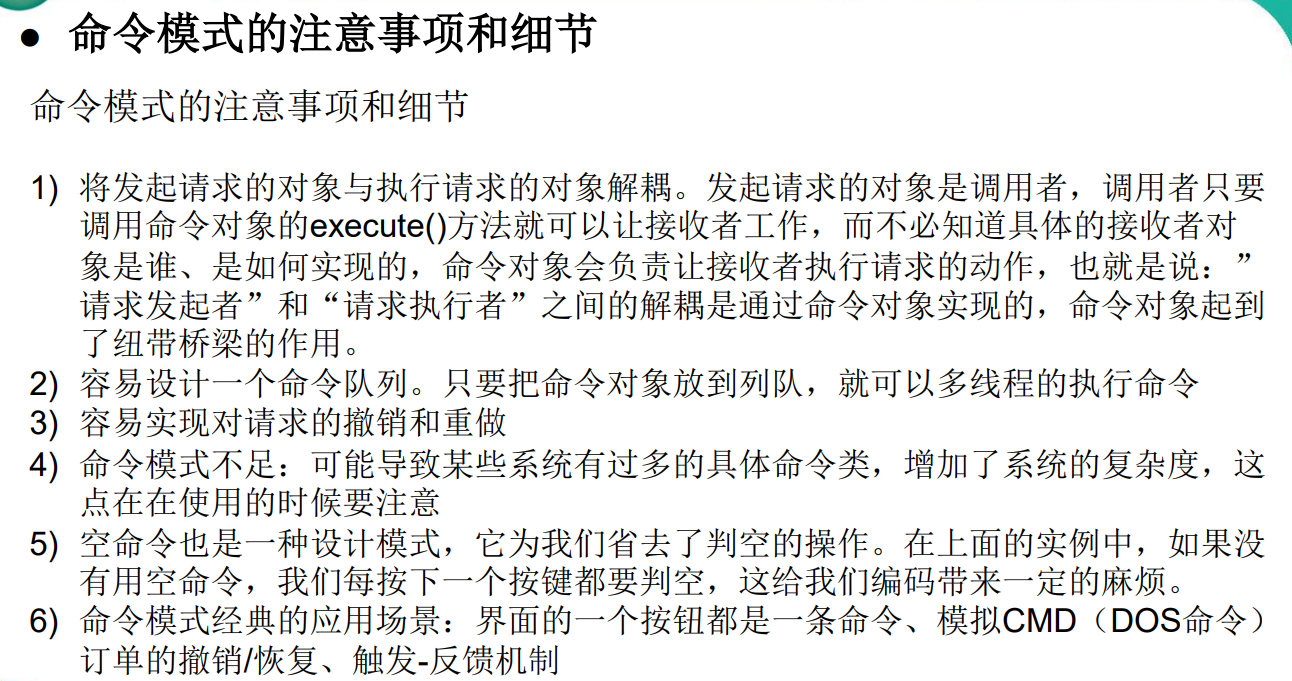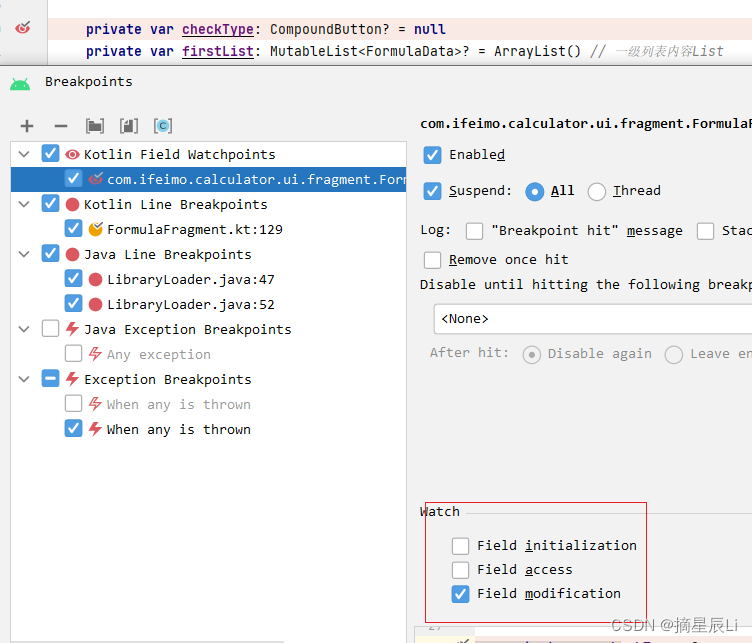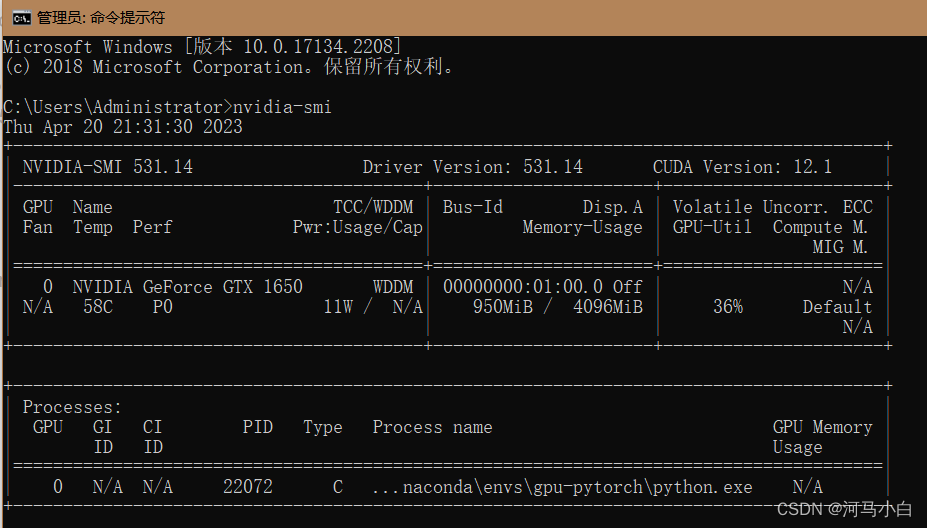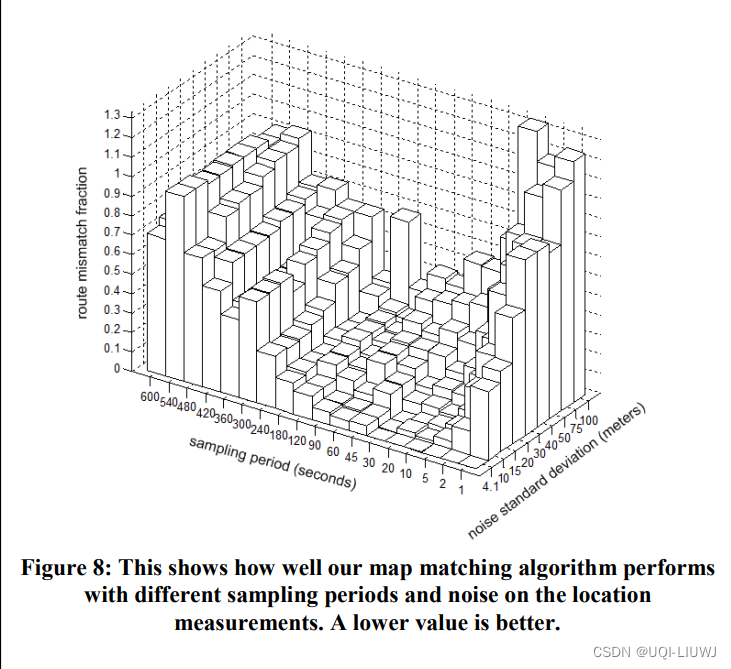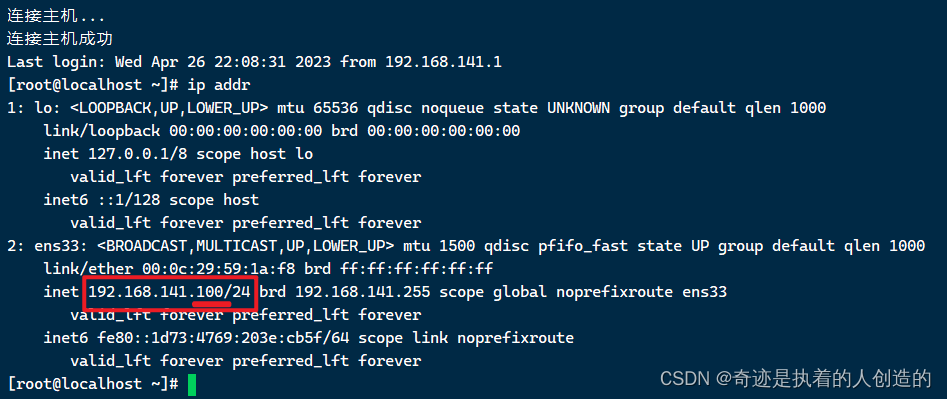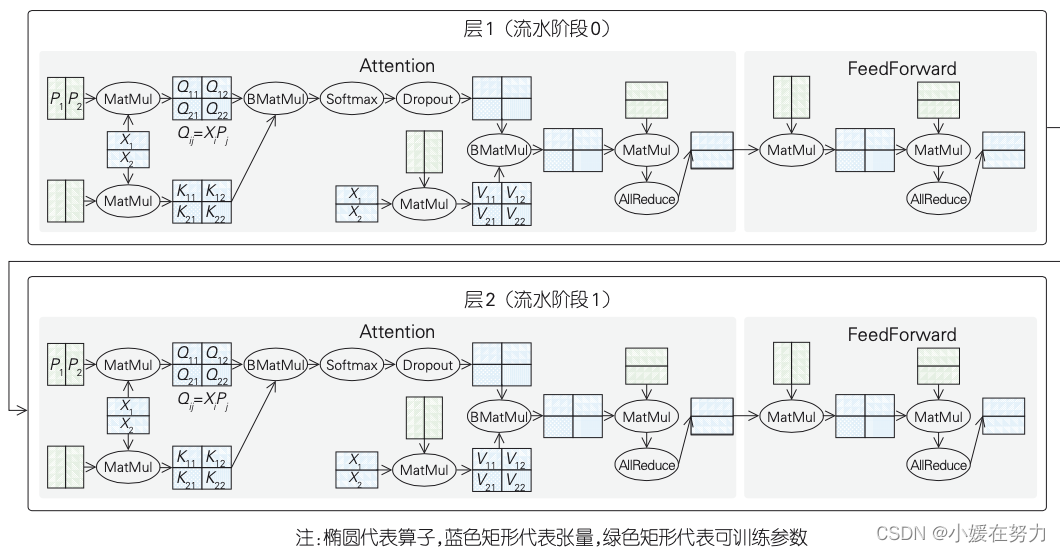文章目录
- 前言
- 一、命令模式解决智能生活项目
- 设计思想
- 完整代码
- Command 所有命令的父接口(绑定命令都需要实现)
- LightReceiver 命令接受者
- LightOnCommand / LightOffCommand 将具体的命令进行绑定
- 空命令
- 命令调用者
- Clint 测试
- 添加新的命令,非常简单
- 添加命令接受者 TVReceiver
- 将具体的命令进行绑定 TVOnCommand / TVOffCommand
- Clint 测试
- 二、命令模式在Spring框架JdbcTemplate应用的源码分析
- 三、命令模式的注意事项和细节
前言
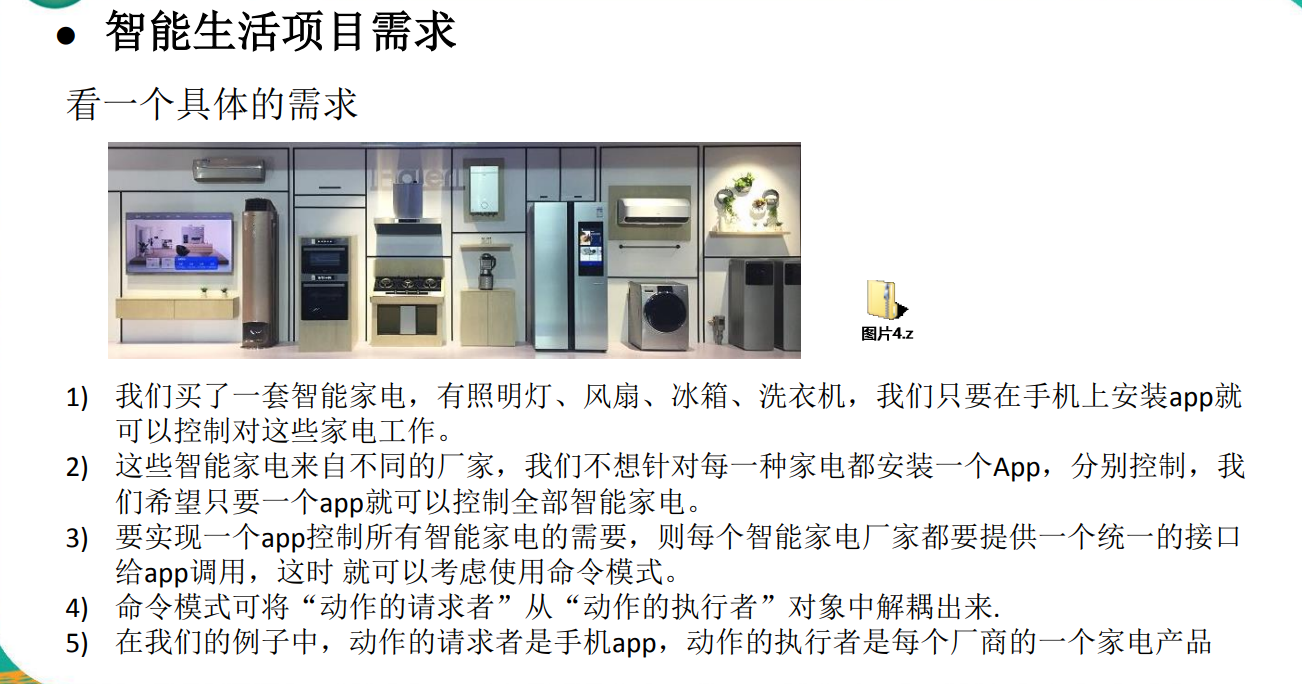
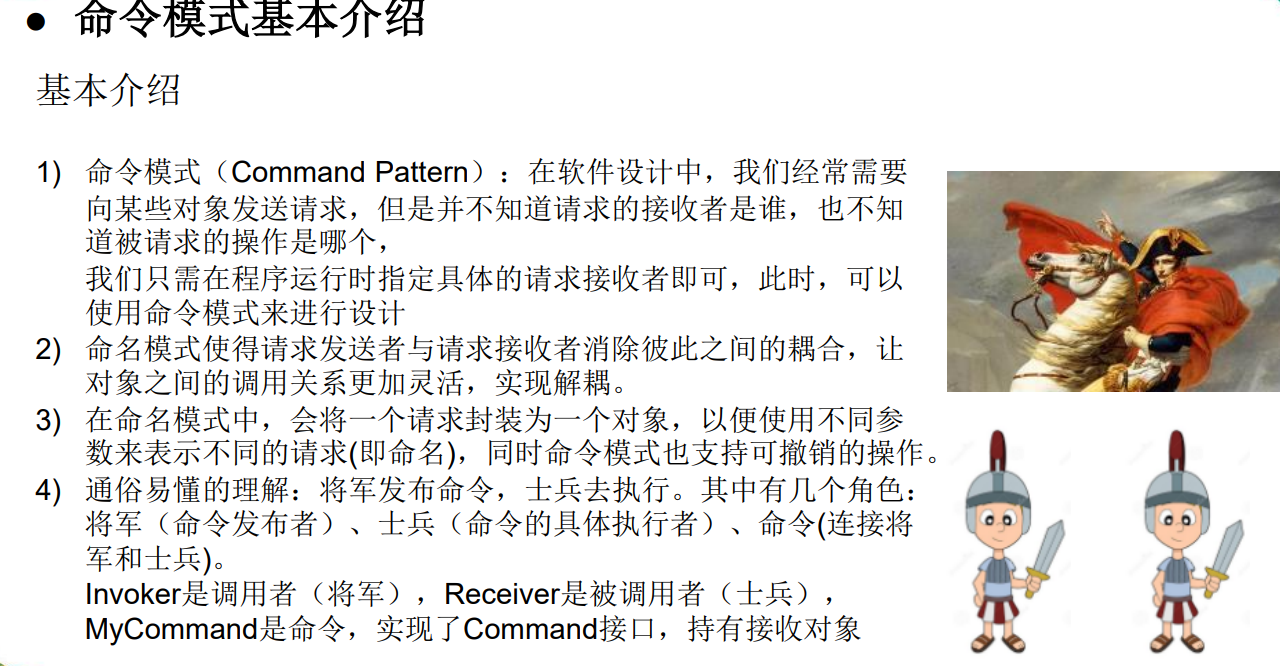
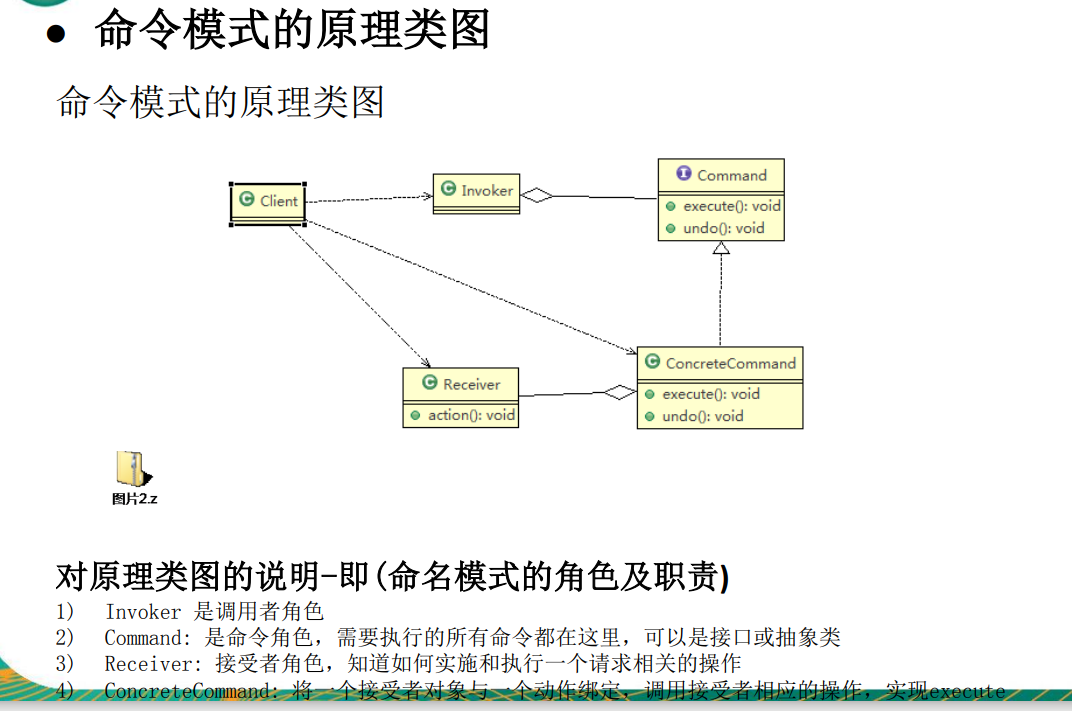
一、命令模式解决智能生活项目
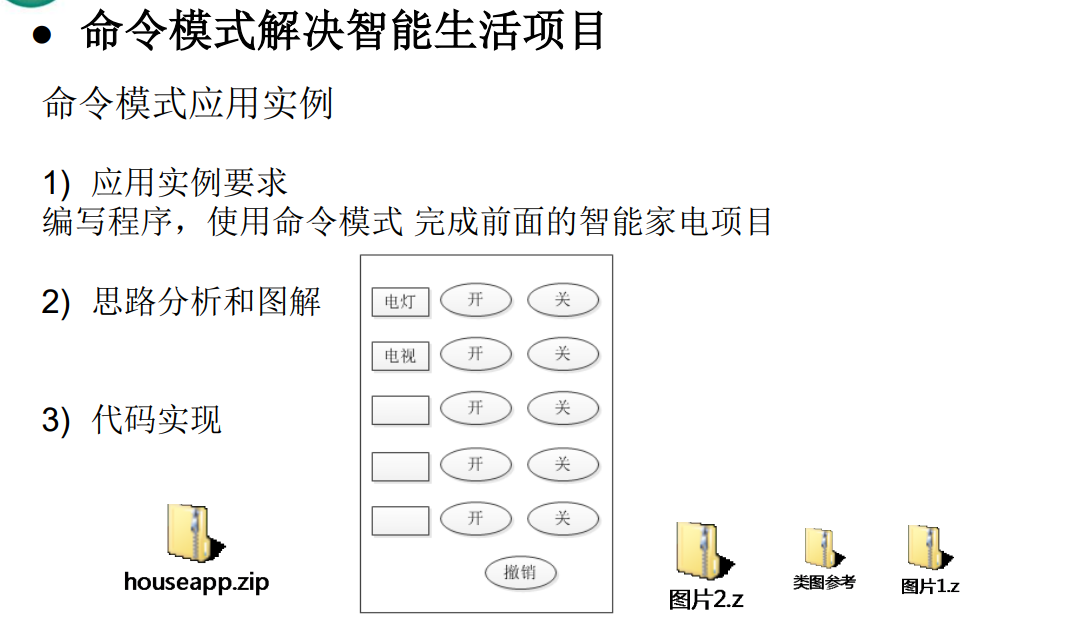
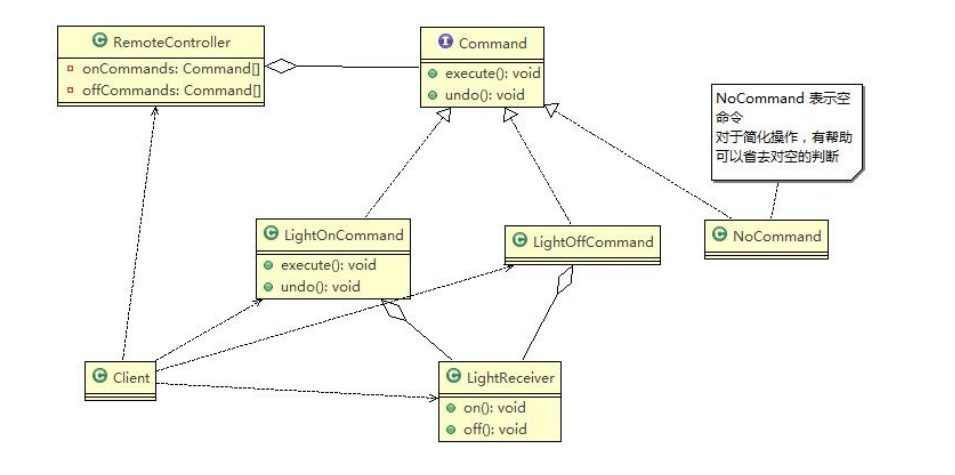
设计思想
命令模式的设计思想是将命令统一管理,调用者并不需要关心谁会去执行命令,只需要发出命令或撤回命令,命令有具体对应的类,比如上面的类图,clint 只需要调用 RemoteController 传入两个 需要初始化的按钮 LightOn 和 LightOff ,对这两个按钮发送命令,命令的具体执行不需要关心,就可以达到开灯或者关灯的操作,也可以通过设置的撤销按钮进行 操作的撤销。
完整代码
Command 所有命令的父接口(绑定命令都需要实现)
package tanchishell.SJMS.command;
//创建命令接口
public interface Command {
//执行动作(操作)
public void execute();
//撤销动作(操作)
public void undo();
}
LightReceiver 命令接受者
package tanchishell.SJMS.command;
public class LightReceiver {
public void on() {
System.out.println(" 电灯打开了.. ");
}
public void off() {
System.out.println(" 电灯关闭了.. ");
}
}
LightOnCommand / LightOffCommand 将具体的命令进行绑定
package tanchishell.SJMS.command;
//开灯 操作为开灯,撤销为关灯
public class LightOnCommand implements Command {
//聚合 LightReceiver
LightReceiver light;
//构造器
public LightOnCommand(LightReceiver light) {
super();
this.light = light;
}
@Override
public void execute() {
//调用接收者的方法
light.on();
}
@Override
public void undo() {
//调用接收者的方法
light.off();
}
}
package tanchishell.SJMS.command;
//关灯 操作为关灯,撤销为开灯
public class LightOffCommand implements Command {
// 聚合 LightReceiver
LightReceiver light;
// 构造器
public LightOffCommand(LightReceiver light) {
super();
this.light = light;
}
/**
* 关闭灯光命令类和打开灯光命令类的 方法调用正好相反
*/
@Override
public void execute() {
// 调用接收者的方法
light.off();
}
@Override
public void undo() {
// 调用接收者的方法
light.on();
}
}
空命令
package tanchishell.SJMS.command;
/**
* 没有任何命令,即空执行: 用于初始化每个按钮, 当调用空命令时,对象什么都不做
* 其实,这样是一种设计模式, 可以省掉对空判断
*/
public class NoCommand implements Command{
@Override
public void execute() {
}
@Override
public void undo() {
}
}
命令调用者
package tanchishell.SJMS.command;
public class RemoteController {
// 开 按钮的命令数组
Command[] onCommands;
Command[] offCommands;
// 执行撤销的命令
Command undoCommand;
// 构造器,完成对按钮初始化
public RemoteController() {
onCommands = new Command[5];
offCommands = new Command[5];
for (int i = 0; i < 5; i++) {
onCommands[i] = new NoCommand();
offCommands[i] = new NoCommand();
}
}
// 给我们的按钮设置你需要的命令
public void setCommand(int no, Command onCommand, Command offCommand) {
onCommands[no] = onCommand;
offCommands[no] = offCommand;
}
// 按下开按钮
public void onButtonWasPushed(int no) { // no 0
// 找到你按下的开的按钮, 并调用对应方法
onCommands[no].execute();
// 记录这次的操作,用于撤
undoCommand = onCommands[no];
}
// 按下开按钮
public void offButtonWasPushed(int no) { // no 0
// 找到你按下的关的按钮, 并调用对应方法
offCommands[no].execute();
// 记录这次的操作,用于撤销
undoCommand = offCommands[no];
}
// 按下撤销按钮
public void undoButtonWasPushed() {
undoCommand.undo();
}
}
Clint 测试
package tanchishell.SJMS.command;
public class Client {
public static void main(String[] args) {
//使用命令设计模式,完成通过遥控器,对电灯的操作
//创建电灯的对象(接受者)
LightReceiver lightReceiver = new LightReceiver();
//创建电灯相关的开关命令
LightOnCommand lightOnCommand = new LightOnCommand(lightReceiver);
LightOffCommand lightOffCommand = new LightOffCommand(lightReceiver);
//需要一个遥控器
RemoteController remoteController = new RemoteController();
//给我们的遥控器设置命令, 比如 no = 0 是电灯的开和关的操作
remoteController.setCommand(0, lightOnCommand, lightOffCommand);
System.out.println("--------按下灯的开按钮-----------");
remoteController.onButtonWasPushed(0);
System.out.println("--------按下灯的关按钮-----------");
remoteController.offButtonWasPushed(0);
System.out.println("--------按下撤销按钮-----------");
remoteController.undoButtonWasPushed();
}
}
输出
--------按下灯的开按钮-----------
电灯打开了..
--------按下灯的关按钮-----------
电灯关闭了..
--------按下撤销按钮-----------
电灯打开了..
添加新的命令,非常简单
添加命令接受者 TVReceiver
package tanchishell.SJMS.command;
public class TVReceiver {
public void on() {
System.out.println(" 电视机打开了.. ");
}
public void off() {
System.out.println(" 电视机关闭了.. ");
}
}
将具体的命令进行绑定 TVOnCommand / TVOffCommand
package tanchishell.SJMS.command;
public class TVOnCommand implements Command{
// 聚合 TVReceiver
TVReceiver tv;
// 构造器
public TVOnCommand(TVReceiver tv) {
super();
this.tv = tv;
}
@Override
public void execute() {
// 调用接收者的方法
tv.on();
}
@Override
public void undo() {
// 调用接收者的方法
tv.off();
}
}
package tanchishell.SJMS.command;
public class TVOffCommand implements Command {
// 聚合 TVReceive
TVReceiver tv;
// 构造器
public TVOffCommand(TVReceiver tv) {
super();
this.tv = tv;
}
@Override
public void execute() {
// 调用接收者的方法
tv.off();
}
@Override
public void undo() {
// 调用接收者的方法
tv.on();
}
}
Clint 测试
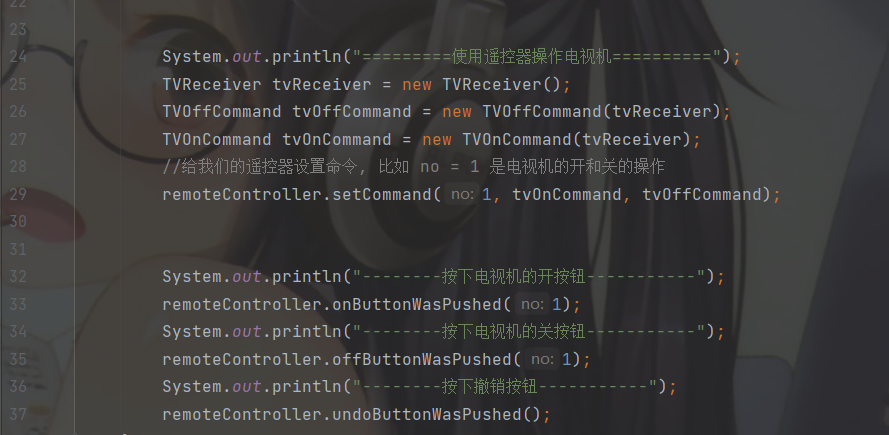
package tanchishell.SJMS.command;
public class Client {
public static void main(String[] args) {
//使用命令设计模式,完成通过遥控器,对电灯的操作
//创建电灯的对象(接受者)
LightReceiver lightReceiver = new LightReceiver();
//创建电灯相关的开关命令
LightOnCommand lightOnCommand = new LightOnCommand(lightReceiver);
LightOffCommand lightOffCommand = new LightOffCommand(lightReceiver);
//需要一个遥控器
RemoteController remoteController = new RemoteController();
//给我们的遥控器设置命令, 比如 no = 0 是电灯的开和关的操作
remoteController.setCommand(0, lightOnCommand, lightOffCommand);
System.out.println("--------按下灯的开按钮-----------");
remoteController.onButtonWasPushed(0);
System.out.println("--------按下灯的关按钮-----------");
remoteController.offButtonWasPushed(0);
System.out.println("--------按下撤销按钮-----------");
remoteController.undoButtonWasPushed();
System.out.println("=========使用遥控器操作电视机==========");
TVReceiver tvReceiver = new TVReceiver();
TVOffCommand tvOffCommand = new TVOffCommand(tvReceiver);
TVOnCommand tvOnCommand = new TVOnCommand(tvReceiver);
//给我们的遥控器设置命令, 比如 no = 1 是电视机的开和关的操作
remoteController.setCommand(1, tvOnCommand, tvOffCommand);
System.out.println("--------按下电视机的开按钮-----------");
remoteController.onButtonWasPushed(1);
System.out.println("--------按下电视机的关按钮-----------");
remoteController.offButtonWasPushed(1);
System.out.println("--------按下撤销按钮-----------");
remoteController.undoButtonWasPushed();
}
}
输出
=========使用遥控器操作电视机==========
--------按下电视机的开按钮-----------
电视机打开了..
--------按下电视机的关按钮-----------
电视机关闭了..
--------按下撤销按钮-----------
电视机打开了..
二、命令模式在Spring框架JdbcTemplate应用的源码分析
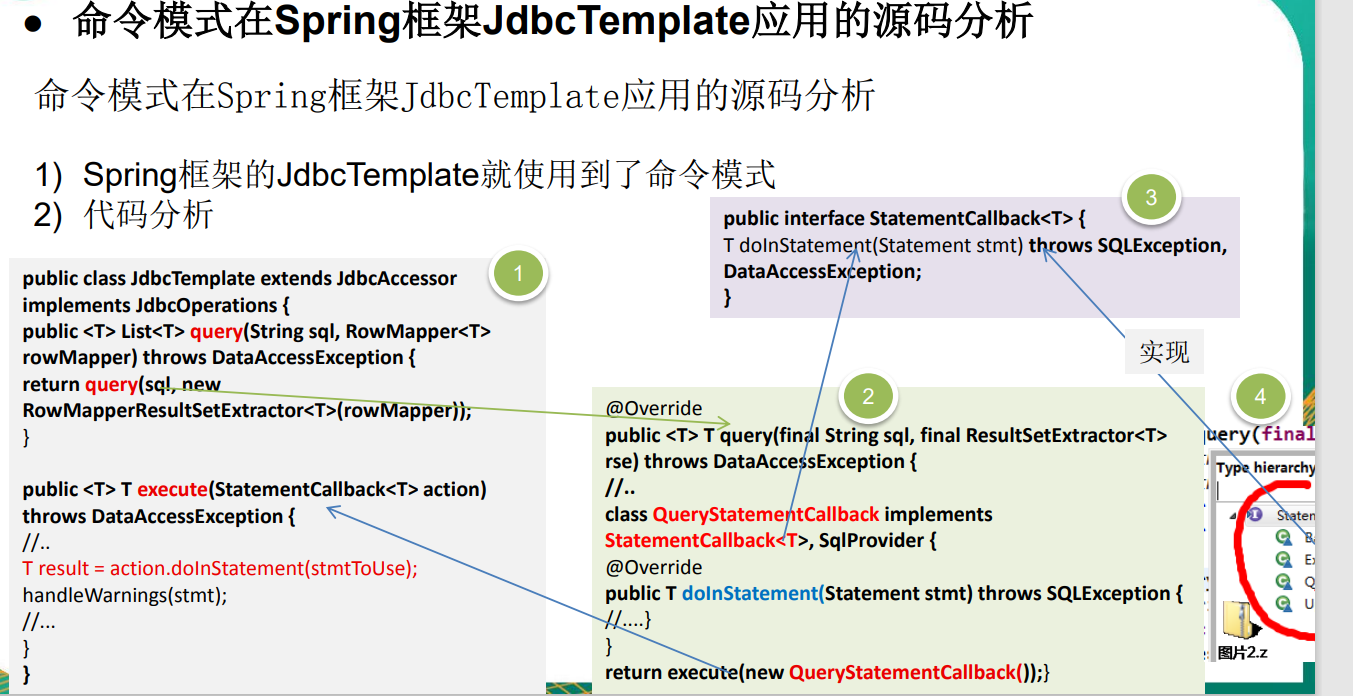
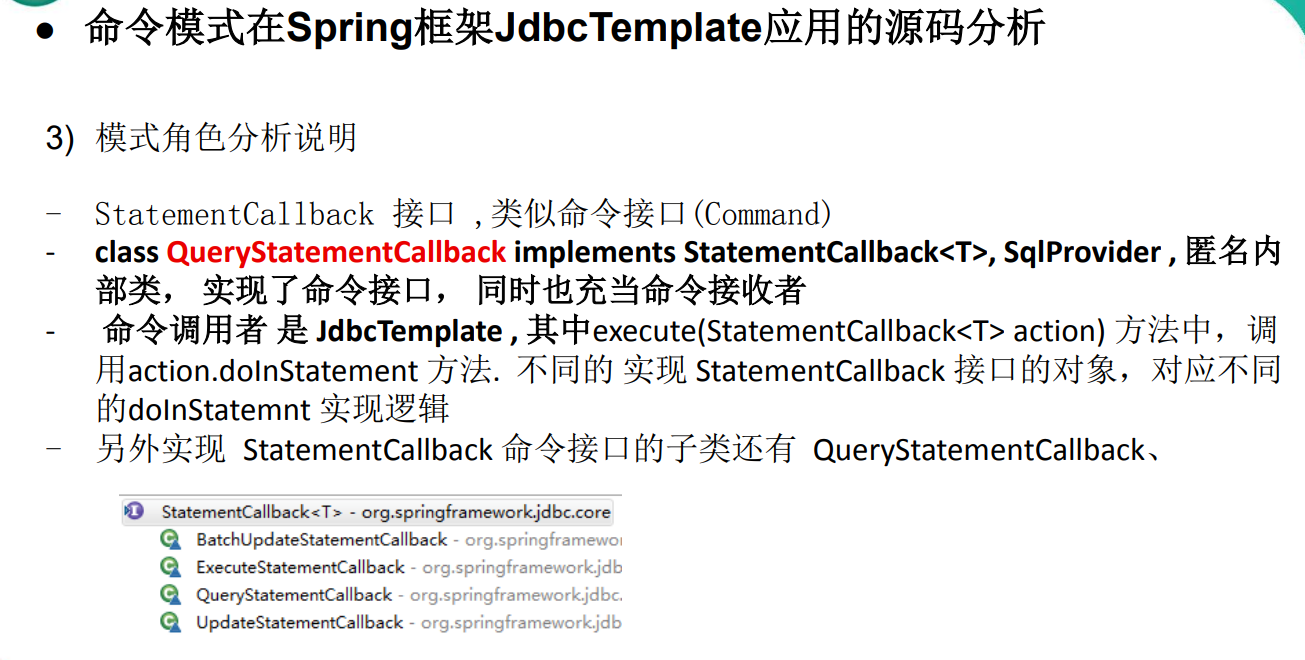
三、命令模式的注意事项和细节
